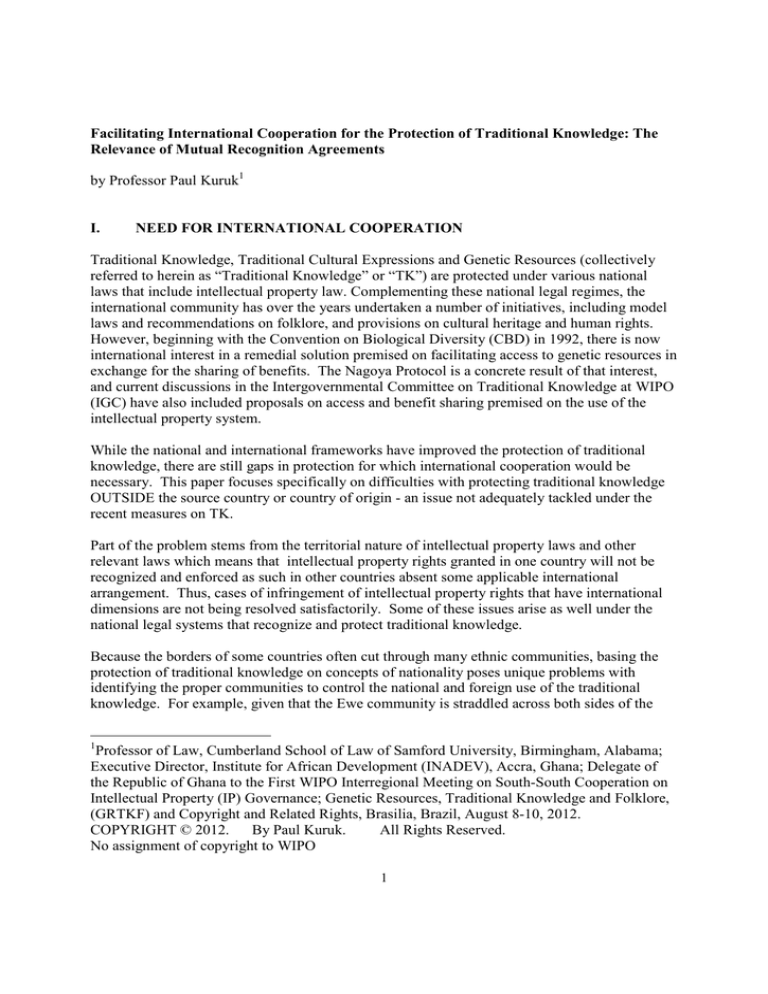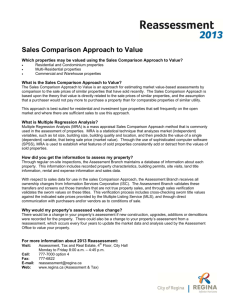
Facilitating International Cooperation for the Protection of Traditional Knowledge: The
Relevance of Mutual Recognition Agreements
by Professor Paul Kuruk1
I.
NEED FOR INTERNATIONAL COOPERATION
Traditional Knowledge, Traditional Cultural Expressions and Genetic Resources (collectively
referred to herein as “Traditional Knowledge” or “TK”) are protected under various national
laws that include intellectual property law. Complementing these national legal regimes, the
international community has over the years undertaken a number of initiatives, including model
laws and recommendations on folklore, and provisions on cultural heritage and human rights.
However, beginning with the Convention on Biological Diversity (CBD) in 1992, there is now
international interest in a remedial solution premised on facilitating access to genetic resources in
exchange for the sharing of benefits. The Nagoya Protocol is a concrete result of that interest,
and current discussions in the Intergovernmental Committee on Traditional Knowledge at WIPO
(IGC) have also included proposals on access and benefit sharing premised on the use of the
intellectual property system.
While the national and international frameworks have improved the protection of traditional
knowledge, there are still gaps in protection for which international cooperation would be
necessary. This paper focuses specifically on difficulties with protecting traditional knowledge
OUTSIDE the source country or country of origin - an issue not adequately tackled under the
recent measures on TK.
Part of the problem stems from the territorial nature of intellectual property laws and other
relevant laws which means that intellectual property rights granted in one country will not be
recognized and enforced as such in other countries absent some applicable international
arrangement. Thus, cases of infringement of intellectual property rights that have international
dimensions are not being resolved satisfactorily. Some of these issues arise as well under the
national legal systems that recognize and protect traditional knowledge.
Because the borders of some countries often cut through many ethnic communities, basing the
protection of traditional knowledge on concepts of nationality poses unique problems with
identifying the proper communities to control the national and foreign use of the traditional
knowledge. For example, given that the Ewe community is straddled across both sides of the
1
Professor of Law, Cumberland School of Law of Samford University, Birmingham, Alabama;
Executive Director, Institute for African Development (INADEV), Accra, Ghana; Delegate of
the Republic of Ghana to the First WIPO Interregional Meeting on South-South Cooperation on
Intellectual Property (IP) Governance; Genetic Resources, Traditional Knowledge and Folklore,
(GRTKF) and Copyright and Related Rights, Brasilia, Brazil, August 8-10, 2012.
COPYRIGHT © 2012.
By Paul Kuruk.
All Rights Reserved.
No assignment of copyright to WIPO
1
Ghana-Togo border, could work produced in Togo using the traditional knowledge of the
Togolese Ewes that is also common to the Ghanaian Ewes be found to be a reproduction
prohibited under Ghana law? Related to this problem is the question of control of the use of
works of traditional knowledge abroad when those works are also common to ethnic groups
spanning several countries. For example, kente cloth, which is widely used in the United States
for making garments, ties, caps, bags, stoles, etc., is produced by the Ashanti, Ewe and Nzima
communities found in Ghana, the Ivory Coast and Togo. While it is obvious that those
communities have valid claims with respect to the use of their kente pieces abroad, it is unclear
how and to what degree the relevant national governments can assert rights on behalf of their
respective nationals. An international cooperation agreement could be used as the basis for
developing reasonable solutions to these cross-border issues.
A common feature in the access and benefit sharing schemes of the CBD, the Nagoya Protocol,
the African Model Law on access to TK and other regional frameworks is that they offer
solutions that depend on contractual agreements as a method of regulating access to genetic
resources. However, to the extent contract based solutions are largely domestic strategies, like
intellectual property rights, they are inadequate for tackling certain problems associated with the
use of genetic resources which have international dimensions. For example, the best drafted
contract is meaningless if the user party who breaches the contract moves out the state where the
contract was entered into to live in another country. Without cooperation from the second
country, courts in the first country cannot acquire jurisdiction over the party to make him account
for the breach.
Similar issues arise if the party moves out of the country to avoid paying a judgement issued
against him for breach of an access and benefit sharing contract. Without cooperation again
from the second country, it will be impossible to enforce the judgment.
Thirdly, if the party in breach of the contract acquires intellectual property rights in the second
country related to the transferred genetic resources, again without the second state moving
cooperatively to revoke the IP rights, the indigenous groups with ownership claims in the
resource in general would have no adequate legal remedies. Their option may be to travel to the
second state to initiate legal action which would be an unattractive option attendant with high
costs and uncertainties given the indigenous groups lack of familiarity with foreign laws.
Fourth, where resources are found in more than one country, there is the potential danger of
companies playing indigenous communities against each other to attract the lowest practices. An
international or regional arrangement would discourage this by coming up with a predetermined
formula for allocating benefits that result from the exploitation of such common resources.
Therefore, an international access scheme which imposes responsibilities on TK provider and
user countries in terms of cooperation in connection with jurisdictional, enforcement, allocation
of benefits and other matters will improve considerably the regulatory environment on traditional
knowledge.
COPYRIGHT © 2012.
By Paul Kuruk.
No assignment of copyright to WIPO
All Rights Reserved.
2
II.
ALTERNATIVES TO A GLOBALLY BINDING TREATY ON TRADITIONAL
KNOWLEDGE
However, some countries in the North are opposed to a legally binding instrument on traditional
knowledge that will address these gaps in protection. While the countries see the need for
international action, they would prefer the matter be addressed under guidelines or best practices
and are therefore reluctant to make the specific commitments necessary for an effective
protection of traditional knowledge. The tactics adopted by these countries at the IGC reveal a
lukewarm, if not obstructionist attitude in the quest for solutions. No wonder that we are more
than 10 years into the IGC process and the work is still incomplete.
The differing attitudes by developed and developing countries on TK suggests that a regional
approach reflecting cooperation among like-minded countries has a greater chance of success
than a more encompassing global treaty. To this end, countries that already recognize and
protect traditional knowledge would enter into cooperation agreements to regulate uses of
traditional knowledge. This could entail the adoption of separate and flexible mechanisms
between interested TK source countries and user countries, focusing on the particular types of
traditional knowledge for which protection is required, as well as the form of protection that
makes sense from the perspective of the participating countries. Such cooperation agreements,
unlike international treaties, would be more flexible mechanisms to address specific TK user
country concerns that have contributed to the reluctance of certain countries to commit to the
protection of traditional knowledge .
III.
MUTUAL RECOGNITION AGREEMENTS AS A POLICY RESPONSE
1.
Relevance of the Principle of Reciprocity
What should be the basis for recognising and protecting TK under such cooperation
arrangements? Two important principles to consider in this regard are national treatment and
reciprocity.
National treatment, which is a principle of non-discrimination, holds that an eligible foreign right
holder should enjoy the same rights as domestic nationals. On the other hand, under reciprocity
or reciprocal recognition, whether a country grants protection to nationals of a foreign country
depends on whether that country in turn extends protection to nationals of the first country.
Reciprocity requires Country A to recognize the rights of nationals from Country B residing in
Country A only where Country B also recognizes the rights of nationals of Country A resident in
Country B.
Protection of traditional knowledge on the basis of reciprocity offers the possibility of fuller
protection for TK rights holders in user countries than protection on the basis of national
treatment, especially where the user countries do not have adequate laws on TK. Under the
COPYRIGHT © 2012.
By Paul Kuruk.
All Rights Reserved.
No assignment of copyright to WIPO
3
principle of reciprocity, Country A may recognize and enforce the traditional knowledge rights
of a person from Country B even where Country A does not recognize such rights under its
domestic (national) laws. This flexibility of the reciprocity approach makes it suitable for the
protection of traditional knowledge in countries that have been reluctant to sign on to a broad and
binding international scheme that might require changes in their domestic laws. Thus, under the
reciprocity principle, those countries could still commit to protecting foreign traditional
knowledge without making such changes.
As an implicit endorsement of the principle, one of the early model intellectual property
instruments advocated by both WIPO and UNESCO emphasized the need to protect traditional
knowledge on the basis of reciprocity. Specifically, the Model Provisions for National Laws on
the Protection of Expressions of Folklore Against Illicit Exploitation and Other Prejudicial
Actions required that “[e]xpressions of folklore developed and maintained in a foreign country
[be] protected . . . subject to reciprocity.” (Paragraph 14). Similarly, the principle of reciprocity
is incorporated in Article 13 of UNESCO’s Illicit Trade Convention, which enables an aggrieved
signatory party to file claims, based on its domestic cultural property laws, in another signatory
state to recover cultural property illegally removed from the complainant’s jurisdiction. Thus,
incorporation of the principle of reciprocity in a regional or international cooperation agreement
would be consistent with international practice.
2.
Reciprocity and Mutual Recognition Agreements
An increasingly popular application of the reciprocity principle is found in Mutual Recognition
Agreements (MRAs). MRAs have been used particularly in cases where harmonization of
different trade international standards have proved difficult. In general, mutual recognition
agreements are easier to negotiate than efforts to harmonize regulatory regimes. Unlike
harmonization, which requires jurisdictions to make their regulations identical or at least more
similar, MRAs can permit entry and sale of products or services without requiring fundamental
regulatory convergence. A potential benefit of MRAs is that principles agreed upon under
MRAs could form the basis of an international agreement open to other countries.
Similarly, participation by developing countries in mutual recognition agreements on TK could
influence the adoption of future international instruments on the subject. Indeed, the African
Group at WIPO has advocated the use of mutual recognition agreements in relation traditional
knowledge.
Certain features of the MRA make it worth pursuing as a mechanism for the protection of
traditional knowledge. Unlike an agreement based on national treatment, an MRA can be
negotiated and implemented where the regulatory systems differ, as when one country provides
for rights not recognized in the other. Thus, Country A could agree to recognize and protect
traditional knowledge rights from Country B on the basis of an agreement reached between the
two countries, even though the former does not have laws respecting traditional knowledge.
COPYRIGHT © 2012.
By Paul Kuruk.
No assignment of copyright to WIPO
All Rights Reserved.
4
3.
Scope of Mutual Recognition Agreements on Traditional Knowledge
The principal objective of an MRA would be to create a suitable environment in the TK user
country to facilitate access to, as well as prevent the misappropriation of, traditional knowledge
originating from the source country or source countries party to the MRA. To assuage TK user
country concerns about difficulties in identifying traditional knowledge and the appropriate
methods of regulating it, the MRA should carefully delineate the scope of protectible matter and
clarify the general customary law principles that govern access, including prior informed consent
and benefit sharing requirements and other obligations that could be imposed on users by
indigenous rights holders. It will also be necessary to specify the prohibited acts of
misappropriation with respect to which sanctions would be sought in the TK user country.
To ensure the effectiveness of the MRA, it is of vital importance that a central agency is
established in the TK user country to administer the MRA’s provisions. (TK Agency) A
principal role of the TK Agency would be to articulate, assert and defend the traditional
knowledge rights of the TK source country subject to exploitation in the TK user country. A
second role of the TK Agency would be to act as the conduit either for processing requests to use
traditional knowledge received from interested persons in TK user country, or passing to the TK
source country benefits received from uses of TK in the TK user country.
The MRA should provide a general definition as well as an illustrative list of categories of
traditional knowledge to be regulated under the agreement. It is equally important to qualify the
definition with a provision that the determination whether a particular item or practice of
traditional knowledge was covered by the MRA for purposes of authorizing access or enforcing
traditional knowledge rights in the TK user country would be made by the TK Agency in
consultation with the TK source country.
It would be useful to require in the MRA that applications in the TK user country for access to
traditional knowledge be directed to the TK Agency to be forwarded to the traditional knowledge
source country or source countries unless the TK Agency is also authorized to provide consent
for the particular type of traditional knowledge.
The MRA should recognize the right of the traditional knowledge source countries or the TK
Agency to impose reasonable obligations or conditions on applicants for access to traditional
knowledge. Such obligations may include the disclosure to the TK Agency of significant
commercial uses of traditional knowledge and any intellectual property sought or obtained in
connection therewith. To help enforce these obligations as they relate to intellectual property
rights, the TK user country could require patent offices to reject applications for patents derived
from traditional knowledge, the transfer of which to the TK user countries was not certified by
the TK Agency or traditional knowledge source country as being in compliance with national
requirements governing access and benefit sharing.
The description of prohibited acts of misappropriation of traditional knowledge should include
the unauthorized acquisition and use of traditional knowledge or obtaining commercial benefits
from the acquisition and use of traditional knowledge, when the person has reason to know or
COPYRIGHT © 2012.
By Paul Kuruk.
No assignment of copyright to WIPO
All Rights Reserved.
5
ought to have known that it was improperly acquired. As an illustration, the MRA might refer to
the following as acts of misappropriation: (a) the acquisition of protected traditional knowledge
by theft, fraud, or other illegal and unfair means; (b) failure to comply with prior informed
consent procedures governing acquisition and use of traditional knowledge; (c) failure to comply
with benefit sharing arrangements or provide appropriate compensation to the relevant holders
for commercial uses of traditional knowledge, especially where benefits were realized from such
utilization; (d) use of traditional knowledge in violation of the terms of any contract governing
access to traditional knowledge, executed either in the TK user country or the source countries;
(e) misrepresentations that a product or service is authentic traditional knowledge; and (f)
distortion or use of an item of traditional knowledge in a way prejudicial to the honor, dignity or
cultural interests of the community in which it originates.
Effective enforcement systems would be critical to the use of the MRA for the protection of
traditional knowledge. At a minimum, the MRA should permit rights holders in the traditional
knowledge source countries through the TK Agency to file lawsuits in the TK user country to
protect their rights. This type of right is not novel and is found in several cultural heritage
instruments. Sanctions for unauthorized uses of traditional knowledge may include injunctive
relief, seizure and forfeiture of infringing material, accounting for profits, damages, attorneys’
fees, and costs. Criminal penalties such as jail terms should also be considered for very
egregious cases.
BIBIOGRAPHY
1. Paul Kuruk, Goading a Reluctant Dinosaur: Mutual Recognition Agreements as a Policy
Response to the Misappropriation of Traditional Knowledge in the United States 34
PEPPERDINE LAW. REV. 629 (2007).
2. Paul Kuruk, The Role of Customary Law Under Sui Generis Frameworks on Intellectual
Property Rights in Traditional and Indigenous Knowledge 17 INDIANA INTERNATIONAL &
COMPARATIVE LAW REVIEW. 67 (2007) .
3. Paul Kuruk, Protecting Folklore Under Modern Intellectual Property Regimes, 48
AMERICAN UNIVERSITY LAW REVIEW 769-849 (1999).
4. African Model Legislation for the Protection of the Rights of Local Communities, Farmers
and Breeders, and the Regulation of Access to Biological Resources (2000).
5. Nagoya Protocol on Access to Genetic Resources and the Fair and Equitable Sharing of
Benefits Arising from their Utilization to the Convention on Biological Resources (2011).
COPYRIGHT © 2012.
By Paul Kuruk.
No assignment of copyright to WIPO
All Rights Reserved.
6



